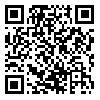Volume 21, Issue 4 (December 2023)
Iranian Rehabilitation Journal 2023, 21(4): 601-610 |
Back to browse issues page
Ethics code: IR. TUMS.FNM. REC.1399.174
Download citation:
BibTeX | RIS | EndNote | Medlars | ProCite | Reference Manager | RefWorks
Send citation to:



BibTeX | RIS | EndNote | Medlars | ProCite | Reference Manager | RefWorks
Send citation to:
Amiri M, Dalvand H, Rassafiani M, Almasi A. The Relationship Between Manual Ability and Self-care in Children Aged 1-8 Years With Spastic Cerebral Palsy: A Cross-sectional Study. Iranian Rehabilitation Journal 2023; 21 (4) :601-610
URL: http://irj.uswr.ac.ir/article-1-1944-en.html
URL: http://irj.uswr.ac.ir/article-1-1944-en.html
1- Department of Occupational Therapy, School of Rehabilitation, Tehran University of Medical Sciences, Tehran, Iran.
2- School of Allied Health, Exercise and Sports Sciences, Charles Sturt University, Bathurst, Australia.
3- Department of Epidemiology, School of Health, Arak University of Medical Sciences, Arak, Iran.
2- School of Allied Health, Exercise and Sports Sciences, Charles Sturt University, Bathurst, Australia.
3- Department of Epidemiology, School of Health, Arak University of Medical Sciences, Arak, Iran.
Abstract: (3010 Views)
Objectives: Limitations in the ability to perform manual functions decrease the individual’s participation in activities of daily living (ADLs). Thus, it is required to study the relationship between manual skills and self-care activities in children. This study aims to investigate the relationship between manual ability and self-care in children with spastic cerebral palsy at the ages of 1 to 8 years.
Methods: In this cross-sectional study, 125 children aged 1-8 years with spastic cerebral palsy who were chosen by the convenience sampling method from 8 occupational therapy clinics in Tehran City, Iran, in 2022 were studied. The evaluation tools were manual ability classification system (MACS), mini-manual ability classification system (Mini-MACS), pediatric evaluation of disability inventory (PEDI), and cognitive level form designed in the SPARCLE project. After collecting the data, Stata software, version 14 was used to analyze data using chi-square, Spearman correlation coefficient, Mann-Whitney, Kruskal-Wallis, and regression.
Results: In this research, the mean age of the children was 54.2±15 months and 43.2% had a cognitive level >70. The mean self-care and mobility in children were 49.65±30.60 and 40.78±26.97, respectively. With increasing age, self-care and mobility of children showed a significant increase (P<0.001). No significant difference was observed between boys and girls in self-care and mobility (P<0.05). By changing the education level of the main caregiver, no significant difference was found in self-care and mobility (P<0.05). With the increase in children’s cognitive ability level and MACS level, self-care and mobility improved significantly (P<0.001). Moreover, the level of MACS and mobility with the highest beta values (-0.530 and 0.512, respectively) showed a greater contribution to the prediction of self-care.
Discussion: The results showed that with increasing age, cognitive ability level, and MACS level, self-care and mobility improve significantly in children with spastic cerebral palsy. Therefore, it is suggested to pay more attention to manual ability to improve self-care and mobility in these children.
Methods: In this cross-sectional study, 125 children aged 1-8 years with spastic cerebral palsy who were chosen by the convenience sampling method from 8 occupational therapy clinics in Tehran City, Iran, in 2022 were studied. The evaluation tools were manual ability classification system (MACS), mini-manual ability classification system (Mini-MACS), pediatric evaluation of disability inventory (PEDI), and cognitive level form designed in the SPARCLE project. After collecting the data, Stata software, version 14 was used to analyze data using chi-square, Spearman correlation coefficient, Mann-Whitney, Kruskal-Wallis, and regression.
Results: In this research, the mean age of the children was 54.2±15 months and 43.2% had a cognitive level >70. The mean self-care and mobility in children were 49.65±30.60 and 40.78±26.97, respectively. With increasing age, self-care and mobility of children showed a significant increase (P<0.001). No significant difference was observed between boys and girls in self-care and mobility (P<0.05). By changing the education level of the main caregiver, no significant difference was found in self-care and mobility (P<0.05). With the increase in children’s cognitive ability level and MACS level, self-care and mobility improved significantly (P<0.001). Moreover, the level of MACS and mobility with the highest beta values (-0.530 and 0.512, respectively) showed a greater contribution to the prediction of self-care.
Discussion: The results showed that with increasing age, cognitive ability level, and MACS level, self-care and mobility improve significantly in children with spastic cerebral palsy. Therefore, it is suggested to pay more attention to manual ability to improve self-care and mobility in these children.
Article type: Original Research Articles |
Subject:
Occupational therapy
Received: 2023/04/8 | Accepted: 2023/06/27 | Published: 2023/12/1
Received: 2023/04/8 | Accepted: 2023/06/27 | Published: 2023/12/1
Send email to the article author








